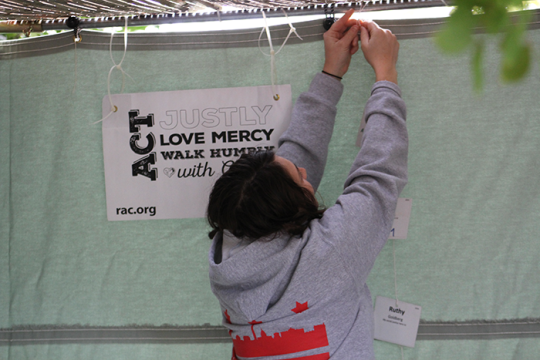
Conversations about Hanukkah are few and far between in our ancient texts; most of what the Talmud records about Hanukkah is within a few pages in the Shabbat tractate. But, as is so often the case, those millennia-old words have grown in significance as we prepare for Hanukkah this year.
The Sages taught in a baraita (a rabbinic teaching): It is a to place the Hanukkah lamp at the entrance to one's house on the outside, so that all can see it. If one lives upstairs, they place it at the window adjacent to the public domain.
In one of the first (and only) teachings about the itself, we learn that not only are we obligated to light the candles, but we are to do so publicly. The candles of Hanukkah, we learn later, are to have no other use; unlike the Shabbat candles, which are allowed to provide light to the household, the Hanukkah candles are there simply to shine light. The rabbis make clear - they are to shine light outwards, alerting the neighborhood, the community, and perhaps the whole world, to their presence. To do so is not only to bring light into the darkness, but also to make a public and powerful statement of faith and identity.
I was born and raised in New York City, and since then, I've lived in Washington, D.C., the northwest suburbs of Chicago, Jerusalem, and Los Angeles. Neighborhood stores always featured a hanukkiyah, as did our building's lobby - and they were also set to the correct number of candles. My elementary school choir included Hanukkah songs - and not just ", Dreidel;" we went for the deep cuts; I still remember being asked to teach the proper pronunciation for "Mi Yimalel." All this to say, lighting the hanukkiyah year after year of my childhood never felt like a courageous act of faith.
Even in Los Angeles, where I live now, I am no longer sure that is true. Because what I did not know then, I do know now: It takes courage to place a hanukkiyah in the window, it takes courage to celebrate Hanukkah in a Christmas-normative world, and it takes courage to call out the Jewishness of your home at a time when it might feel more comfortable to keep it hidden.
We learn from the next part of the baraita that perhaps sharing your hanukkiyah with the world was always a fraught decision:
...in a time of danger, one places it on the table and that is sufficient to fulfill their obligation.
Our history has, of course, been rife with these times of danger, with years and decades and even centuries when it would not be safe or even legal to place a hanukkiyah in the window. In the shadow of rising antisemitism, many of us are left wondering - is this a time of danger? Is this the moment to bring the hanukkiyah indoors? And - if we do - what are we teaching ourselves and other members of our community about identity and hiddenness, knowing that it is a privilege to have that choice.
The Talmud does not answer this question for us, but a few pages later, the rabbis offer a lesson that I think might speak to the moment.
What happens, the rabbis ask, if one must choose between buying wine for Shabbat or oil for the hanukkiyah? Which takes precedence?
On the surface, the answer should be simple. Based on the usual logic of the Talmud, we should say that the wine wins out: there is a repeated concept that we prioritize the regular need over the special one. In other words, we need kiddush wine weekly, so we should buy that. But the rabbis introduce something else here, an idea which changes the answer entirely: Rava resolves that the Hanukkah lamp takes precedence due to the public nature of the miracle.
The rabbis understand the obligation of lighting the hanukkiyah to be twofold. We are enjoined to bring light into our lives, to celebrate the miracle that happened in these days, at that time. We light the candles for all the reasons that we may have learned as children - because the Maccabees defeated the Greeks, because the oil lasted for eight days, because we need light in the darkest seasons. But even more than our own celebration, we are meant to publicize the miracle - to tell the world our story, our survival, and our strength.
Placed in the window, the hanukkiyah is more than a candelabra. It is a statement of identity, a reminder to ourselves and to the world that we are still here, still strong, and still celebrating.
To light the lights of Hanukkah is an act of faith and a statement of hope. To light the lights of Hanukkah is to tell the world that we refuse to sit in the darkness. It is to share the miracle - not of the Maccabees or the oil - but of Jewish life and, more importantly, Jewish joy.
Chag Orim Sameach - Wishing you a happy festival of lights!
Related Posts

Teens Make Their Voices Heard by Voting


